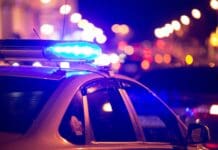“A Secret Service agent assigned to protect Nancy Reagan accidentally shot himself during a firearms training session at a California range,” upi.com reports. “The bullet struck him in the hip, causing a wound that was described as not life-threatening. The division assigned to protect the wife of the late President Ronald Reagan had rented part of the Ventura County Sheriff’s Department range in Camarillo for a routine training session.” Not so routine now, eh Mr. Bond? And I think we can narrow this down a bit. I reckon the Agent shot himself whilst drawing or re-holstering his weapon. If so, that’s a Presidential pardon of not good . . .
Armed self-defense is s a bit like flying an airplane, only more so. We’re talking long stretches of boredom punctuated by moments of sheer terror. In the piloting biz, the heavy stuff usually occurs during two major events: take-off and landing. In firearms terms, things can go seriously Tango Uniform during the unholstering and holstering portion of the program.
In a gunfight, your ability to bring your weapon to bear in a fast and effective manner is likely to be the difference between life and death—regardless of whether you actually fire the weapon or not. Not to put too fine a point on it, the first combatant to establish dominance or land a telling blow wins. You gotta be quick and controlled. If you’re not, you could shoot yourself or an innocent bystander or . . . miss. That’s not the responsible thing to do.
To draw your weapon properly, you need to master a large number of variables. You need to know how to draw with different weapons (if applicable) and various types of clothing (including gloves). You need to know to respond to threats from multiple directions (i.e. turning and firing). You need to know how to draw with your weak hand (in case your strong hand is out of action).
You need to be able to draw whilst standing, sitting or lying down (you may have been knocked the ground). You should be able to draw whilst moving; including drawing, moving and seeking cover and/or concealment all at the same time. And you need to know how to think while you draw, analyzing tactics as you bring out your gun. Deciding whether or not to shoot and whom to shoot.
And those are just the basics—not including perfecting all the elements of a “proper draw” (e.g., turning the gun on target as soon as it leaves the holster). Or trigger discipline. Which is, after all, the most basic of basics. Do I really need to say this (Gabe)? Keep your finger off the trigger during un-holstering and re-holstering. That way, you won’t shoot yourself like Nancy’s fancy firearms protector. Oh, and don’t point the gun at yourself either.
There’s a simple way to avoid both of these bad habits: a spotter. When you practice drawing, you need to focus your eyes on the target. Get someone wise to the ways of drawing a gun to watch your draw to make sure you’re not doing yourself a secret disservice.
Truth be told, if a fellow agent had been watching the federal employee in question practice, he or she might have been able to intervene and prevent the Agent’s negligent discharge. How, in fact, did the Agent acquire those bad habits in the first place? There’s some kind of systemic failure here. Don’t let yourself fall into the same trap.
Anyway, a responsible gun owner knows how to straighten up and fly right during a gun fight. And that means proper holster technique. In the event that your range doesn’t allow drawing, find another range. It’s that important. As a certain limping Secret Service Agent would attest.




I was at the range recently and the group in the next lane had a new shooter with them. After she finished shooting she proceeded to look down the barrel of her pistol while her finger was still on the trigger. Lucky for her our range officer grabbed the pistol and removed her from the line. He then gave her a good tongue lashing on how she could have shot herself or someone else.
I read a story a couple of years ago about a sheriff who shot himself while holstering his Glock. Turned out that he was wearing an anorak wind breaker with a drawstring with one of those plastic doohickys to tighten the drawstring. The doohicky found its way into the trigger guard, hooked against the holster, and the string disengaged the trigger safety and blammo. The Secret Service seems to like anoraks when they are not wearing suits. I wonder if that’s what happened here.
Yet another example of how the phrase “leave it to the highly trained professionals” always gives me a bit of a chuckle. Or a bit of a mouth-vomit depending how many died as a result of their ‘competence’…
TTACer, I think that the only plastic doohicky involved in the ND was the officer’s Glock.
I wonder if his ego hurts more than his hip?
This is one of the reasons I don’t care much for Glocks. There’s no manual safety. It’s true, he should have been paying more attention when he holstered his weapon, but you don’t often hear about this kind of thing happening to guys with Hi-Powers or 1911’s.
Also, why is a video of what appears to be a SASS event on the Irresponsible Gun Owner of the Day article? Isn’t their policy “If you don’t attend the safety briefing, you don’t shoot.”?
Dude, really?
Comments are closed.